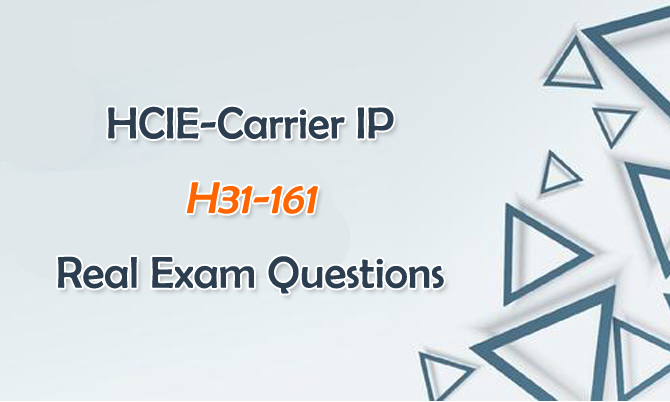Latest HCIE-Carrier IP(Written) H31-161 real exam questions have been cracked, which will be helpful for you to pass H31-161 exam and the first step for you to earn HCIE-Carrier IP certification. The certification is intended for users, partner engineers, and ICT practitioners from carriers, they need to master the use of Huawei datacom products, related technologies and specific skills of carriers. To prepare Huawei H31-161 exam well, the related H31-161 exam information, knowledge content and real exam questions are helpful in the preparation.

HCIE-Carrier IP H31-161 Exam
Exam Type: Written examination
Exam Format: Single choice, Multiple choices, Judgments
Time: 90 minutes
Passing Score/Total Score: 600/1000
Exam Cost: 300 USD
Language: Chinese, English
H31-161 Huawei Knowledge Content
Huawei Certification H31-161 knowledge contents cover the following sections.
1.Advanced routing protocol feature 15%
2.Advanced MPLS Features 25%
3.High availability (HA) feature 15%
4.QoS feature 7%
5.Advanced multicast protocol feature 7%
6.BRAS basic access and authentication technology 7%
7.Security technology base 6%
8.IP MAN and backbone network planning 10%
9.New technologies and network evolution of fixed networks 8%
Study HCIE-Carrier IP H31-161 Real Exam Questions
HCIE-Carrier IP (Written) H31-161 real exam questions are the latest version in the market, which can help you test all the above knowledge contents. Share some Huawei certification H31-161 real exam questions and answers below.
1.On the OSPF network, which of the following statements about the authentication function of the OSPF protocol are true?
A. The OSPF protocol supports area authentication and interface authentication.
B. The interface authentication mode must be consistent with the area authentication mode. For Example, interface and area are authentication in simple or MDS mode or are not authenticated.
C. The interface authentication mode can be different from the area authentication mode.
D. The authentication function of the OSPF is implemented by parameter settings in hello packets.
Answer: A, C, D
2.The VRRP is enabled on the firewall dual-system Intranet users use NAT to access extranet FTP services Which of the following statements are true?
A. The NAT cannot be used in easy IP mode.
B. VRIDs of the VRRP must be bound with the NAT during NAT configuration in the outbound direction between domain.
C. VRIDs of the VRRP do not need to be bound with the NAI during NAI configuration in the outbound direction between domains.
D. The FTP Nat Alg function must be enabled on the firewall
Answer: A, B, D
3.Which functions docs the beater network NMS mainly provide?
A. Monitoring network traffic
B. Packet delay
C. Monitoring device load(CPU and Memory)
D. Switchover tune of a device's active/standby system
Answer: C
4.Which statement about the Ethernet clock synchronization technology used m actual solutions is true?
A. The IEEE 1588 technology requites the intermediate node to support transparent clock transmission
B. The CES packet recovery technology requires the intermediate node lo support transparent clock transmission
C. The NTP technology requires the intermediate node to support transparent clock transmission
D. The 802 1aS technology requires the intermediate node to support transparent clock transmission
Answer: A
5.With the SA, which of the following, option is correct?
A. KE SA is unidirectional
B. IKE SA is bidirectional
C. IPSec SA is unidirectional
D. IPSec SA is bidirectional
Answer: A, D
